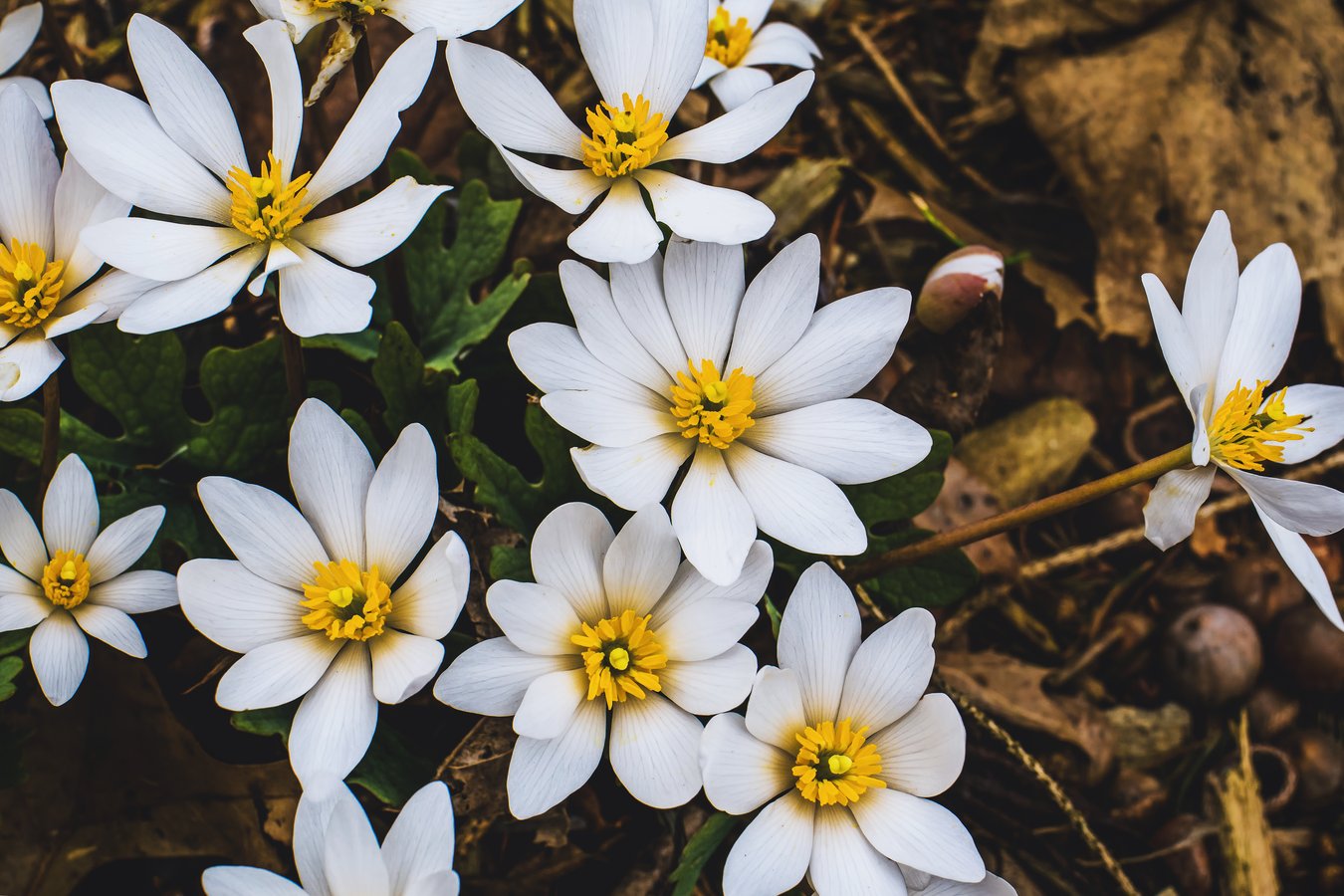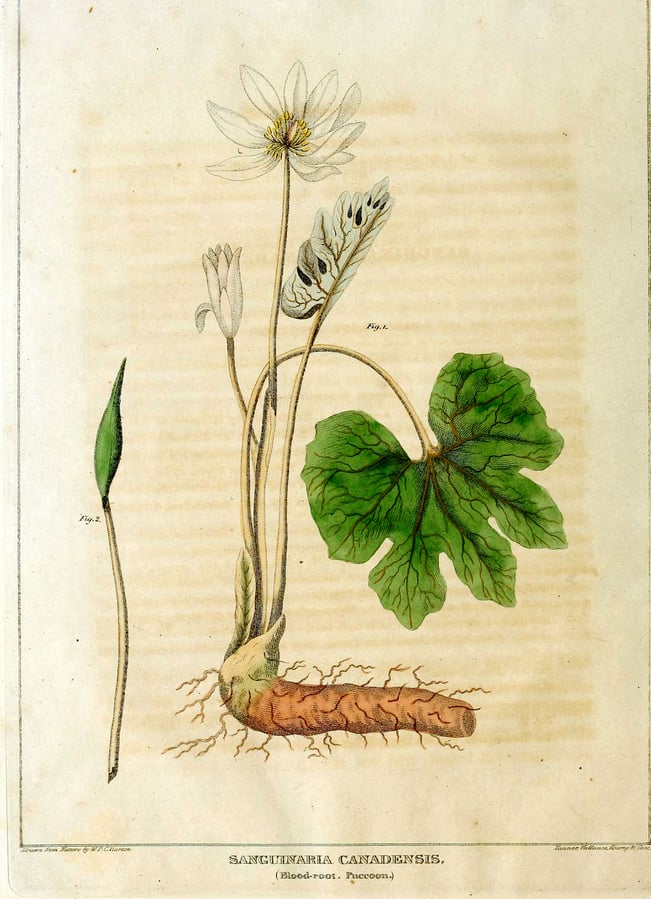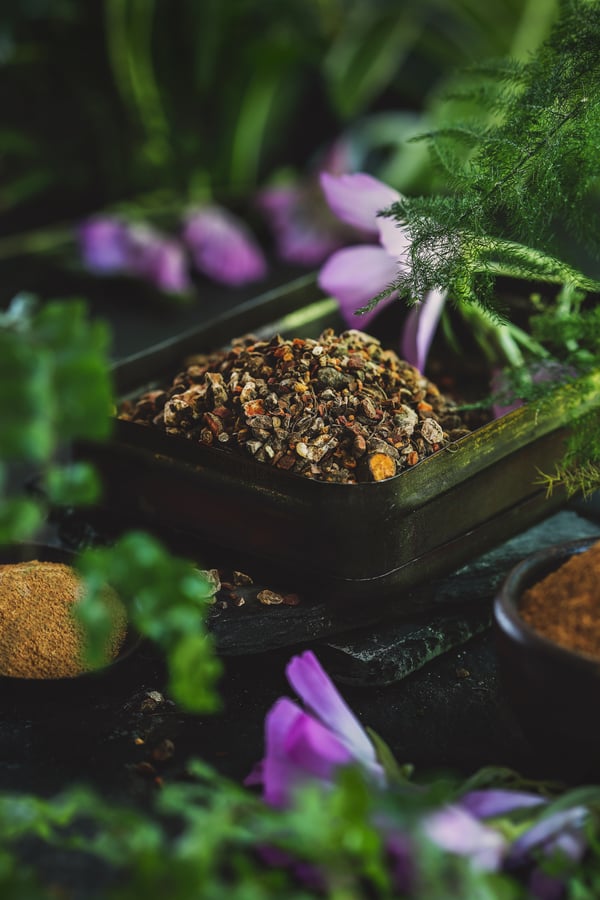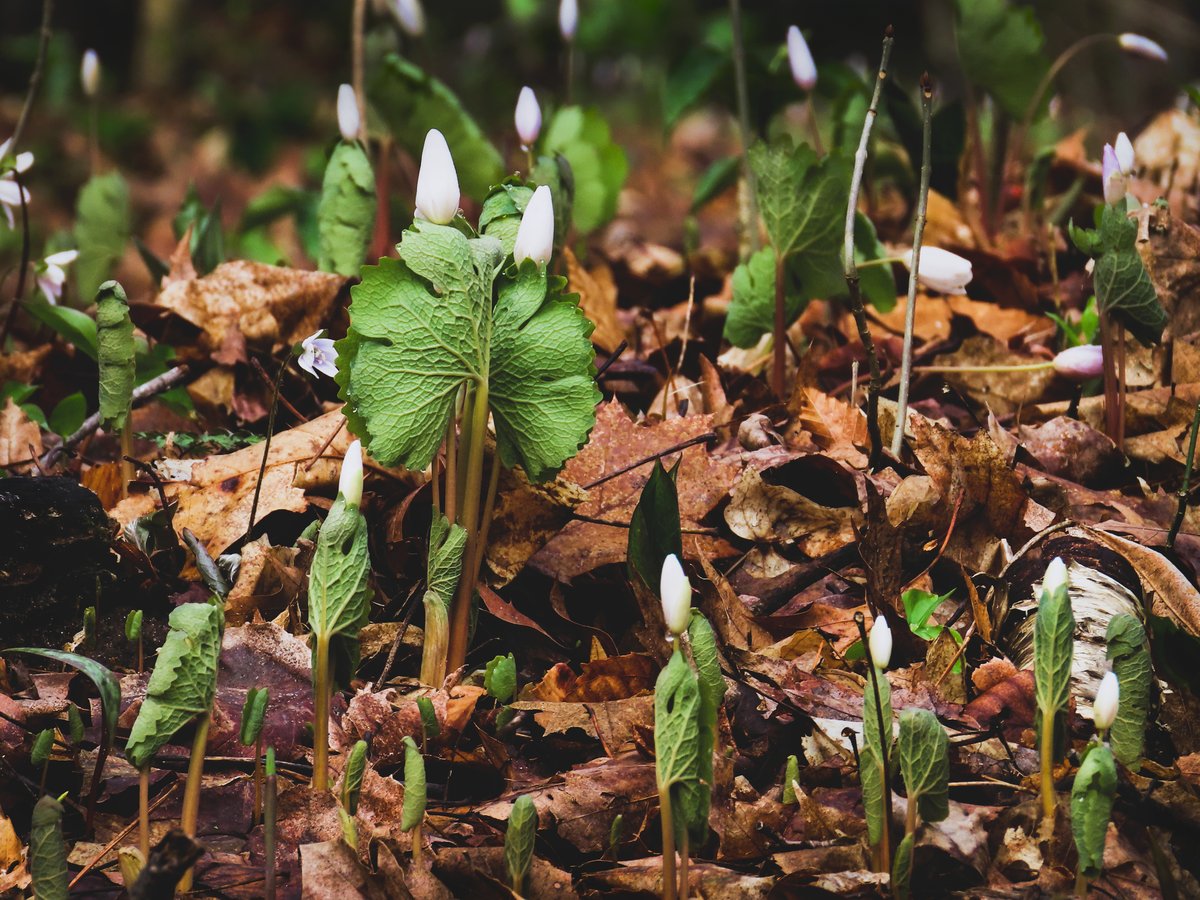Bloodroot (Sanguinaria canadensis) is one of those herbal allies that has been with North Americans for as long as anyone can remember. For thousands of years, First Nations Peoples used different parts of the plant for a wide variety of issues ranging from skin problems to respiratory and gastrointestinal complaints, and also used it to make dyes. European immigrants, eclectic medicine practitioners, and others learned from the local indigenous peoples and by the early 19th century, bloodroot was officially listed in the United States Pharmacopeia. Today, literally tons of bloodroot are wildharvested every year. Let’s talk about the challenges this herbal ally is facing and how we can support its bountiful future.
When we discuss at-risk herbs, we see the same pattern time and again—overharvesting of wild plants for profit is causing and/or exacerbating critical issues for some of our most beloved herbal allies. Often, these precious botanicals can be successfully cultivated, but currently, the vast majority are wildharvested. Such is the case with bloodroot.
Bloodroot Botany
Sanguinaria canadensis var. rotundifolia, or bloodroot (also called bloodwort, red root, and red puccoon) is in the Papaveraceae (poppy) family but is the sole member of its genus. It is native to Canada and the Eastern U.S. and currently ranges from Nova Scotia to northern Florida and from the Atlantic Ocean as far west as Manitoba and Nebraska.
At full height, bloodroot stands only about a foot tall. Although it is named for the characteristic color of the root and its latex, people add this little perennial to their gardens for its clusters of early spring, white-petaled flowers, and pretty, deeply-lobed foliage. The flowers last just a few days, opening in the morning to show off buttery-yellow center stamens and then closing again at night. In the garden, bloodroot is particularly fond of shady areas, rock gardens, and forest edges. When given plenty of humus and well-drained soil, it manages well even in periodic droughts. In the wild, it thrives in acidic forest soils, especially near openings in the tree canopy, so is often found along streams and roadsides.
Bumblebees, honeybees, and syphon flies cross-pollinate bloodroot flowers. If these pollinators fail at this task however, bloodroot can self-pollinate because the flowers are hermaphroditic. After flowering, the seeds form in pods for about a month and when they ripen, they don't just drop, they are ejected, sometimes flying up to 10 feet away! Ants then collect the seeds and store them underground in tidy, linear patterns, which is why we so often see bloodroot growing in the same linear patterns.
When cut, bloodroot exudes a bright orange-red sap that contains isoquinoline alkaloids, red resin, and starch. The environmental conditions the plant grows in will directly impact the concentration of the constituents in this sap; the best environmental conditions result in higher concentrations of active constituents, particularly in the plant’s rhizomes and especially during and just after bloom. Note however that the rhizomes should not be harvested until autumn, after the plant has died back, to give it time to disperse seeds.
Photo from the collection of the Biodiversity Heritage Library.
Is Bloodroot Endangered?
United Plant Savers (UpS) lists bloodroot as “At-Risk.” In 2010, the United States Department of Agriculture classified it as “exploitably vulnerable” in its native region in New York and of “special concern” in Rhode Island.
Several issues are causing this concern. The open, shaded habitat that is ideal for bloodroot and many other plant species in the Eastern woodlands is increasingly threatened by changes in land use, invasive shrubs, dense-growing trees, and more. Additionally, as a myrmecochoric plant, bloodroot faces an extra challenge in some parts of its range. Myrmecochoric plants rely on ants for seed dispersal. Bloodroot seeds have a fatty white substance on them called elaiosome, which ants love. Native ants carry the seeds to their underground colony to eat the elaiosome and then they tidily discard the seed itself in the colony’s midden, which provides an organically rich environment where the seed can germinate. Unfortunately, non-native invasive ants in some areas are threatening this age-old seed dispersal method. Whereas native ants eat the elaiosome without damaging the seed, these non-native ants often damage the seeds and also frequently leave the seeds haphazardly in places other than a midden, where even undamaged seeds cannot germinate or thrive.
These land-use changes and invasive species are exacerbating the pressure that already exists for bloodroot because it is so heavily wildharvested. UpS estimates between 38 and 55 tons of bloodroot are commercially wildharvested each year: some for the herbal products industry and some to be exported to Europe where it is added to animal feed.
Additionally, bloodroot wildharvesting practices are impacting a look-alike plant that has the misfortune to resemble this herbal ally. Thinleaf (Jeffersonia diphylla) has similar appearing flowers, leaves, and roots, but lacks the medicinal alkaloids or red latex that people seek in bloodroot. Because amateur wild harvesters often mistake Jeffersonia diphylla for Sanguinaria canadensis, thinleaf’s situation is officially “endangered” in Georgia and New Jersey and “threatened” in Iowa and New York.
Bloodroot Uses
Bloodroot is a strong botanical and is primarily used today for its bacteria-fighting constituents. You may have seen it in products sold commercially as “drawing salves” or for other skin issues.
In appropriate quantities, dried bloodroot is generally regarded as safe by the U.S. Food and Drug Administration (see caution below). However, it should only be used sparingly in topical applications and with extreme caution in infusions and tinctures. You should never ingest the fresh red juice directly from the roots. Historically, people did consume larger quantities of bloodroot and also the fresh juice, which is why we have myriad accounts of how Sanguinaria canadensis in larger quantities can cause serious nausea, vomiting, damage to the gastrointestinal tract, and even death. For instance, bloodroot was successfully used in dental applications for a time and showed significant benefits to oral health care… but then researchers found that overuse could cause oral leukoplakia (precancerous lesions). Similarly, when used in small quantities, bloodroot is relaxing and soothing to the bronchial muscles, which is why we find it sometimes in lozenges and other formulations that are intended to address periodic coughing or to clear the respiratory passages, but it is imperative to be cautious and work with a qualified, experienced health care practitioner before using bloodroot because it is easy to cross the line and take too much. This is not a beginner’s herb!
Caution: As with most plants that contain isoquinoline alkaloids, bloodroot should never be taken when pregnant or breastfeeding.
How to Help Bloodroot: Bring it Into Your Garden
As demand for this plant increases and nearly all commercial sales are wildharvested, sustainable cultivation of Sanguinaria canadensis is increasingly imperative. You will notice that at Mountain Rose Herbs, we offer a very limited supply of this at-risk herb and are often out of stock, as a result. We only carry cultivated and ethically harvested bloodroot, and would rather be out of stock than offer material that is harvested in a way that will harm the natural stands. If you cannot purchase ethically-sourced bloodroot, please speak with a certified herbalist to find an alternative herbal option.
Gardeners, if you have land in a region where bloodroot can thrive, we hope you will consider bringing this lovely little perennial into your life. Its charming flowers are delightful and you will have the added benefit of sharing space with a powerful herbal ally. Check your local native plant nurseries for seeds, bare roots, or starts. Alternatively, you can purchase bloodroot seeds, bare roots, and potted plants from our friends at Strictly Medicinal Seeds. Do not poach bloodroot plants or roots from the wild!
Bloodroot prefers deep, moist, rich, acidic soil and shade. If you have hardwood trees on your property, you may find bloodroot is particularly happy as ground cover around their base. Plant seeds or starts in the early spring, spacing about six inches apart. Mulch thickly with decomposed leaves, especially if there is any chance of frost. Bloodroot rhizomes often live on the surface and put down feeder roots, so they are vulnerable to cold; in the wild they are normally covered with moss or deep leaf mulch. You can also propagate bloodroot by rhizome division in the fall or early spring—wear gloves and wash your hands after handling the roots. In ideal conditions, bloodroot makes low-lying patches that can live for hundreds of years!
Bloodroot is a powerful herbal ally so remember that a little bit goes a long way. It is important to work with a qualified, experienced herbalist when learning about this precious botanical. We encourage you to explore bloodroot and learn more ways you can be part of positive change for Sanguinaria canadensis.
Interested in learning about another herb that relies on ants for seed dispersal?
Learn about Trillium Plant: An Age-Old Ally That Needs Our Help
You may also enjoy:
- Organic Herb Sourcing: The Bigger Picture
- Tips for Shopping Green & Clean at the Farmers Market
- Why Organic Seaweed is Important
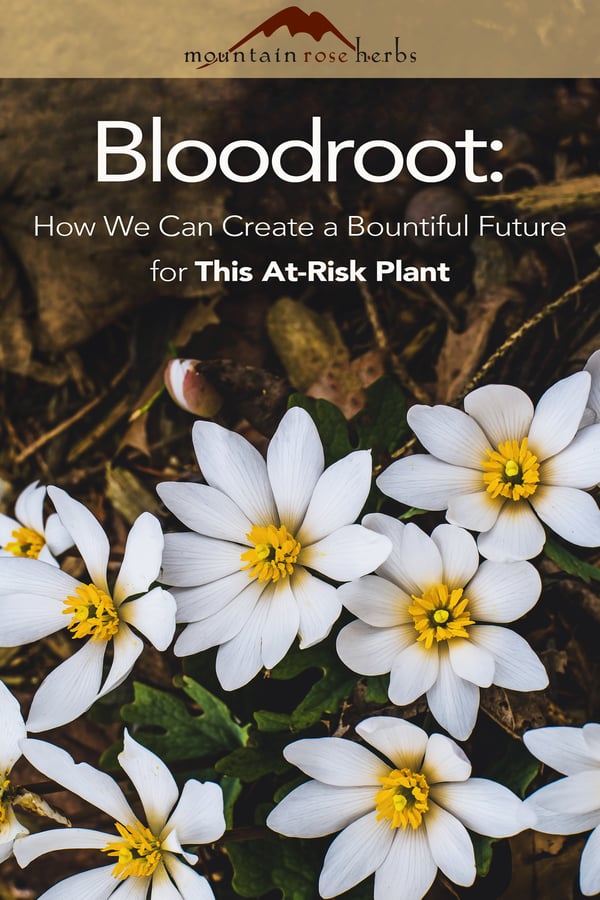
*The statements in this blog have not been evaluated by the Food and Drug Administration. These products are not intended to diagnose, treat, cure, or prevent any disease. We recommend that you consult with a qualified healthcare practitioner before using herbal products, particularly if you are pregnant, nursing, or on any medications. For educational purposes only.

